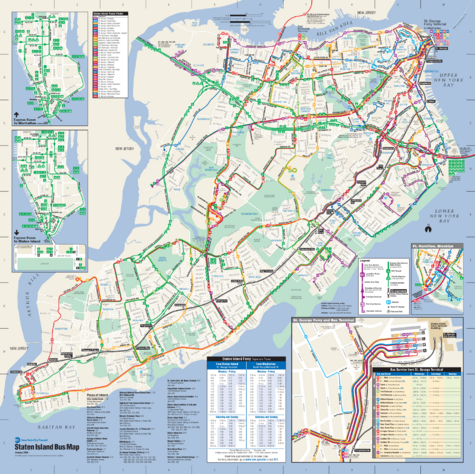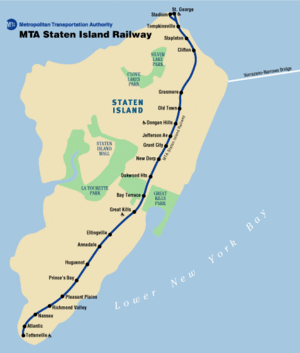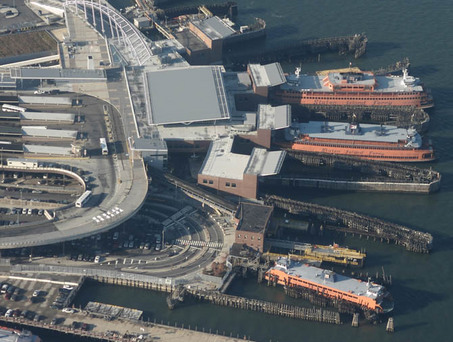Mass Transportation's InfluenceFrom The Peopling of New York City
IntroductionStaten Island is often considered a “forgotten borough.” As residents, we generally feel secluded and are not as recognizable as Brooklyn , the Bronx , Queens or Manhattan; however, we do exist and need to travel as much as anybody else. The roads on Staten Island are horrendous – from potholes littering the streets, to congestion on the roads and the expressway to the continued construction just about everywhere on the island. Many residents on the island drive; however, there are many more that utilize mass transportation, whether it is to leave the island or simply go across it. Alongside its many perks, though, public transportation does have its flaws. Regardless, the mass transit on the island has, like it has across all of New York City, shaped the culture in an influential way. Local, Limited-Stop and Express Buses• The local buses, sometimes referred to as city buses (even if they do not leave the island), are the most common on the island. There are a total of thirty different buses that run on the island – twenty-two of them are local, the other eight are limited-stop buses that follow specific local routes while skipping many of the stops to save time. The island has a few main roads that extend for several miles and intersect with other roads along the way; these are all covered by the buses. There is always a bus to go somewhere; however, sometimes several buses may be required to make a trip, especially if a rider wants to reduce walking time and distance. Regardless, the buses are efficient at what they do. Many of them run non-stop and run as often as every ten to fifteen minutes during peak hours, such as around when school ends, during rush hour and at night. The local buses not only follow their designated routes, but they sometimes have special routes. For example, when the normal high school day ends on Staten Island, commonly used buses wait outside the schools for the students to go home. • The limited-stop buses are alternative versions of normal bus lines and run less often; however, they are more efficient at getting from place to place. For example, students waiting for the s62 on Victory Boulevard in the morning prefer to leave their homes a little earlier to get the limited-stop bus on the same line, the s92. This bus skips many stops, so the students that lived near the bus stop on Victory Boulevard and Manor Road have a faster ride to school. This is a convenience that keeps the buses heavily used. According to the Staten Island Chamber of Commerce, there have been approximately thirty-eight million passengers on Staten Island buses as of 2004. This includes local and express routes. • The express buses are different from the local – while the local buses travel around the island (and a select few that also leave it), the express buses are used to leave the island. These should not be confused with limited-stop buses, which may seem to be “express” lines. There are twenty-four express buses on the island, with nine of those traveling across Hylan Boulevard, one of the island’s longest, most used and main roads. Many people that live on the island work in the city and have to travel there, so many pay the extra fare to take the express bus. These buses are typically much more comfortable and are not as frequent as the local buses. Also, while all local buses pick-up and drop-off passengers going either way along the route, express buses have either “pick-up only” or “drop-off only” stops, with most of the pick-up only stops being on the way to the city and most of the drop-off stops on the way from the city. Staten Island Railway• The Staten Island Railway (SIR) has around twenty stops on the line, from Tottenville to the St. George Ferry, effectively from one end of the island to the other. The Staten Island Chamber of Commerce website estimates that 4.38 million passengers ride the SIR yearly. The railroad is convenient in that it runs for twenty-four hours and is a reliable form of transportation. It does not run as frequently as buses do, which may be considered a drawback. Also, there is only one train like, unlike the subway in the rest of the city. We only have the one railway to take us to and from the ferry and all of the stops in between.
• The train is a good alternative to buses for those living near a station. It is also an easier trip to the ferry terminal for those living far away when compared to the buses. Many of the passengers getting on the train agreed that after the train stopped at the New Dorp station going towards St. George, it took on significantly less passengers per stop than before. The reasoning behind this has to do with the many buses in those areas that would give shorter, less strenuous trips to the ferry, so people closest to the ferry would prefer to take the bus. Staten Island Ferry• The Staten Island Ferry is perhaps the most widely known form of mass transportation Staten Island has to offer. It is, since 1997, a free boat ride to and from Manhattan. The ferry takes on approximately twenty million passengers yearly over thirty-three thousand trips. Like the buses, the ferry runs more frequently during rush hours and less frequently late at night.
ConclusionStaten Island has plenty to offer, among its repertoire including its close proximity to Manhattan. Mass transportation used by the majority living on the island is vital to giving people access to where they need to be in an efficient manner. It is not perfect, but the public transportation offered on Staten Island cannot be deemed any less than vast. There is room for improvement, and hopefully the island can slowly become more and more connected to the rest of the city. There is talk of connecting the SIR to the subway lines in the city, for instance. Progress like this will hopefully bring good for Staten Island so that, one day, we will no longer be referred to as “the forgotten borough.” Sources
|



